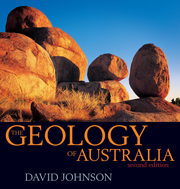Book contents
- Frontmatter
- Contents
- Map
- Preface
- Acknowledgements
- Map of main localities mentioned
- Abbreviations and units
- 1 An Australian perspective
- 2 The Earth: A geology primer
- 3 Building the core of Precambrian rocks
- 4 Warm times: Tropical corals and arid lands
- 5 Icehouse: Carboniferous and Permian glaciation
- 6 Mesozoic warming: The great inland plains and seas
- 7 Birth of modern Australia: Flowering plants, mammals and deserts
- 8 The history and evolution of life on Earth
- 9 Eastern highlands and volcanoes barely extinct
- 10 Building the continental shelf and coastlines
- 11 Great Barrier Reef
- 12 Planets, moons, meteorites and impact craters
- 13 A geological perspective on climate change
- 14 Cycles in a continental journey
- Sources and references
- Figure sources
- Index
7 - Birth of modern Australia: Flowering plants, mammals and deserts
Published online by Cambridge University Press: 05 August 2013
- Frontmatter
- Contents
- Map
- Preface
- Acknowledgements
- Map of main localities mentioned
- Abbreviations and units
- 1 An Australian perspective
- 2 The Earth: A geology primer
- 3 Building the core of Precambrian rocks
- 4 Warm times: Tropical corals and arid lands
- 5 Icehouse: Carboniferous and Permian glaciation
- 6 Mesozoic warming: The great inland plains and seas
- 7 Birth of modern Australia: Flowering plants, mammals and deserts
- 8 The history and evolution of life on Earth
- 9 Eastern highlands and volcanoes barely extinct
- 10 Building the continental shelf and coastlines
- 11 Great Barrier Reef
- 12 Planets, moons, meteorites and impact craters
- 13 A geological perspective on climate change
- 14 Cycles in a continental journey
- Sources and references
- Figure sources
- Index
Summary
So when did Australia as we know it start to form: the unique shape, the animals and birds, the eucalypt forests and deserts? Why are there fossil crocodiles and turtles around Lake Eyre? When did modern birds appear? When did Antarctica become covered in the present ice sheets that cool the southern oceans?
No longer part of the Gondwanan supercontinent, the margin of Australia became a shallow shelf, formed by sediment shed from the inland mountains and by volcanoes along the rifts where Gondwana had broken into its modern fragments.
AUSTRALIA EMERGES
This chapter traces the emergence of the Australian landscape, plants and animals as we know them today. There are two parts to this story, together spanning some 100 million years. The first took 85 million years, during which Australia separated from Antarctica, and the landscapes of both continents were dominated by rainforests, and in Australia later by eucalypt forests. The second started around 15 Ma ago, when the Antarctic ice sheet formed and Australia began to dry out, creating the vast arid interior with its deserts and salt lakes.
All through the geological history up till this point there was no Australian landmass as we know it today. The piece of rock we know as Australia was simply part of much larger continents, first Rodinia and then Gondwana. These supercontinents had experienced submergence beneath vast seas, explosive tremors of long chains of volcanoes, and the uplift and growth of high mountain belts.
- Type
- Chapter
- Information
- The Geology of Australia , pp. 145 - 166Publisher: Cambridge University PressPrint publication year: 2009



